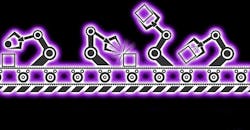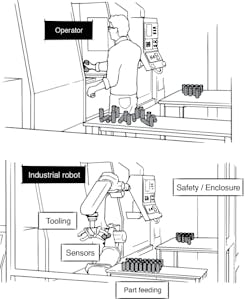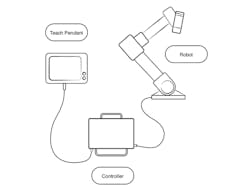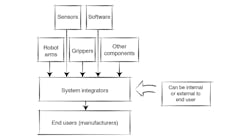A Guide to Making Robots Work in Your Factory
Robots come in many forms, but from now on, I’ll use the word “robot” to refer to the robot arms—also known as industrial robots—involved in manufacturing tasks. What is a robot, anyway? If you’re a manufacturer who wants robots to work in your factory, then you can think of a robot as an “automatically controlled… manipulator” (to paraphrase the International Federation of Robotics’ definition, which is more detailed).
However, there’s not much you can do with just a robotic arm. You need other components, too, which I’ll describe below. That’s why it makes more sense to talk about a robotic cell rather than just a robot. In general, a cell is any station in the manufacturing process, such as on a production line, that’s performing a specific operation.
If the operation is done by a human, the station is known as a manual cell (Fig. 1).
1. This is a general view of a manual and robotic cell.
When factories install a robotic cell, their purpose is to automate a process. That process could be one that’s currently done at a manual cell, or it could be an entirely new function. As you may have guessed by now, a robotic cell is simply a station that includes a robot (Fig. 1, again).
When you buy a robotic arm, it comes with two important elements: the controller, which is the computer that drives its movement, and the teach pendant, which is the user interface that the operator uses to program the robot (Fig. 2).
You can think of the controller as a conventional desktop tower; the teach pendant would be your monitor and keyboard.
2. Setup of industrial robot arm, controller, and teach pendant.
What comes after the robot’s wrist, and what’s added around the robot, varies depending on the application. But no matter the application, your robot will always need to be equipped with other components in order to work properly (Fig. 2, again).
These components might include end-of-arm tools (grippers, welding torches, polishing head, etc.) and sensors (such as force-torque sensors, safety sensors, vision systems, etc.). You’ll need to install the robot on your manufacturing floor by bolting it to a sturdy surface. Installation might also involve adding part-feeding mechanisms, safeguards like protective fencing, and more.
The robotic cell doesn’t only include hardware. The controller comes with some pre-installed software, but you will have to write the program—namely, the list of instructions the robot will follow to perform a specific task.
3. Overview of the robotic cell deployment process.
Figure 3 shows the main steps of the robotic cell deployment process: design, integrate, and operate.
1. The design phase includes all of the tasks needed to move from the manual (or original) process to having the plan and materials for the robotic cell.
2. From there, the integrate phase consists of putting the pieces of the robotic cell together, programming it, and installing the cell on the production line.
3. The operate phase represents the end goal of deployment: A productive robotic cell that does its job properly on an ongoing basis.
Who Provides What?
When you buy a “robot” from a robotics company, you’re typically only getting the arm, controller, and teach pendant. Most robot companies do offer other hardware and software add-ons, but these don’t cover every possible application.
4. Fragmentation of vendors in the industrial robotics industry.
That’s why a whole industry has sprung up around providing application-specific solutions—and it’s why the industrial robotics ecosystem is structured as shown in Figure 4. Different companies specialize in providing various pieces of the solution. Whoever does the cell deployment needs to put these solutions together themselves during the design and integrate phases. These first two phases can be done by an in-house team working for the manufacturer that has bought the robot, or by external contractors called system integrators. Of course, the robot buyer is responsible for operating it, so the third phase—operate—is done by the factory’s team.
For more information, you can download Lean Robotics here.
Samuel Bouchard is the CEO of Robotiq, a company that he co-founded in 2008. Robotiq today serves manufacturers globally and has become a dominant voice in the fast-growing collaborative robots industry. It has also been recognized by Robotics Trends as one of the Top 50 most influential companies in robotics. Bouchard holds a Ph.D. in Mechanical Engineering and a Bachelor's in Engineering Physics from Laval University. He lives in Québec City with his wife and four children.
About the Author
Samuel Bouchard
CEO and Co-Founder
Samuel Bouchard is the CEO of Robotiq, a company that he co-founded in 2008. Robotiq today serves manufacturers globally and has become a dominant voice in the fast-growing collaborative robots industry. It has also been recognized by Robotics Trends as one of the Top 50 most influential companies in robotics. Bouchard holds a Ph.D. in Mechanical Engineering and a Bachelor's in Engineering Physics from Laval University. He lives in Québec City with his wife and four children.





